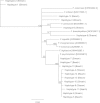Diversity and relative abundance of the bacterial pathogen, Flavobacterium spp., infecting reproductive ecotypes of kokanee salmon
- PMID: 25367228
- PMCID: PMC4228061
- DOI: 10.1186/1756-0500-7-778
Diversity and relative abundance of the bacterial pathogen, Flavobacterium spp., infecting reproductive ecotypes of kokanee salmon
Abstract
Background: Understanding the distribution and abundance of pathogens can provide insight into the evolution and ecology of their host species. Previous research in kokanee, the freshwater form of sockeye salmon (Oncorhynchus nerka), found evidence that populations spawning in streams may experience a greater pathogen load compared with populations that spawn on beaches. In this study we tested for differences in the abundance and diversity of the gram-negative bacteria, Flavobacterium spp., infecting tissues of kokanee in both of these spawning habitats (streams and beaches). Molecular assays were carried out using primers designed to amplify a ~200 nucleotide region of the gene encoding the ATP synthase alpha subunit (AtpA) within the genus Flavobacterium. Using a combination of DNA sequencing and quantitative PCR (qPCR) we compared the diversity and relative abundance of Flavobacterium AtpA amplicons present in DNA extracted from tissue samples of kokanee collected from each spawning habitat.
Results: We identified 10 Flavobacterium AtpA haplotypes among the tissues of stream-spawning kokanee and seven haplotypes among the tissues of beach-spawning kokanee, with only two haplotypes shared between spawning habitats. Haplotypes occurring in the same clade as F. psychrophilum were the most prevalent (92% of all reads, 60% of all haplotypes), and occurred in kokanee from both spawning habitats (streams and beaches). Subsequent qPCR assays did not find any significant difference in the relative abundance of Flavobacterium AtpA amplicons between samples from the different spawning habitats.
Conclusions: We confirmed the presence of Flavobacterium spp. in both spawning habitats and found weak evidence for increased Flavobacterium diversity in kokanee sampled from stream-spawning sites. However, the quantity of Flavobacterium DNA did not differ between spawning habitats. We recommend further study aimed at quantifying pathogen diversity and abundance in population-level samples of kokanee combined with environmental sampling to better understand the ecology of pathogen infection in this species.
Figures



Similar articles
-
Postglacial genetic differentiation of reproductive ecotypes of kokanee Oncorhynchus nerka in Okanagan Lake, British Columbia.Mol Ecol. 1997 Jun;6(6):503-17. doi: 10.1046/j.1365-294x.1997.00213.x. Mol Ecol. 1997. PMID: 9200826
-
Transcriptome-wide comparison of sequence variation in divergent ecotypes of kokanee salmon.BMC Genomics. 2013 May 7;14:308. doi: 10.1186/1471-2164-14-308. BMC Genomics. 2013. PMID: 23651561 Free PMC article.
-
MOLECULAR GENETIC EVIDENCE FOR PARALLEL LIFE-HISTORY EVOLUTION WITHIN A PACIFIC SALMON (SOCKEYE SALMON AND KOKANEE, ONCORHYNCHUS NERKA).Evolution. 1996 Feb;50(1):401-416. doi: 10.1111/j.1558-5646.1996.tb04502.x. Evolution. 1996. PMID: 28568856
-
The Plant-Associated Flavobacterium: A Hidden Helper for Improving Plant Health.Plant Pathol J. 2024 Jun;40(3):251-260. doi: 10.5423/PPJ.RW.01.2024.0019. Epub 2024 Jun 1. Plant Pathol J. 2024. PMID: 38835296 Free PMC article. Review.
-
Responsiveness to surface-groundwater interactions by spawning salmonids: site selection patterns and control mechanisms in lotic ecosystems by Oncorhynchus, Salmo and Salvelinus genera.J Fish Biol. 2025 Jun 3. doi: 10.1111/jfb.70104. Online ahead of print. J Fish Biol. 2025. PMID: 40459440 Review.
References
-
- Eizaguirre C, Lenz TL, Sommerfeld RD, Harrod C, Kalbe M, Milinski M. Parasite diversity, patterns of MHC II variation and olfactory based mate choice in diverging three-spined stickleback ecotypes. Evol Ecol. 2011;25(3):605–622. doi: 10.1007/s10682-010-9424-z. - DOI
Publication types
MeSH terms
Substances
LinkOut - more resources
Full Text Sources
Other Literature Sources
Miscellaneous

